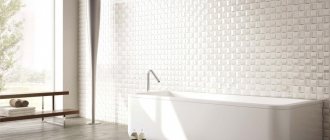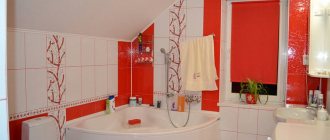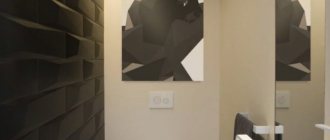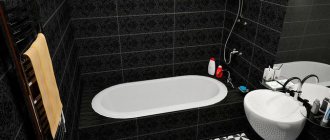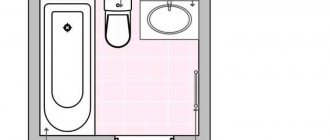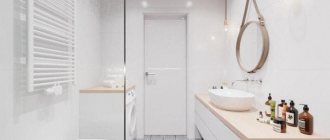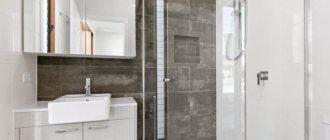No. 1. Deciding on the design
Since the choice of tiles is quite extensive, you can create almost any design in the bathroom. The first thing every buyer pays attention to is the color of the material. So, white color is a win-win option that can be easily combined with bright colored objects. Some people find white color too boring, but with its help you can significantly expand the space of a small bathroom. But still, pure white walls are not an acceptable option, so it is better to choose a warm white shade or dilute the walls with some other color.
Great for the bathroom are blue and green shades , which give a feeling of coolness, as well as warm beige and coffee shades , which create a cozy and relaxing atmosphere in the room. Bright shades are best used as accents, while black tiles make the room gloomy and are contraindicated if the room does not have a window.
taking into account several nuances when working with tiles :
- artificial lighting can change the color of the coating, and this should be taken into account already at the selection stage;
- glossy tiles can tire your eyesight, as they create glare in the light of lamps;
- vertical patterns on tiles can visually make the room taller ;
- tiles with a large pattern if the bathroom is not very large, otherwise it will seem even smaller;
- For small bathrooms , it is naturally better to use tiles in light colors to visually expand the boundaries of the space.
Tile selection
Any type of tile is suitable for a medium to large sized bathroom. For a small room, tiles that are too small are not suitable - they make the room smaller, so it is better to use large and medium-sized options.
It is better to combine mosaics in the bathroom with larger tiles. This allows you to zone the space, visually expand it, create smooth transitions and bright accents.
Dark tiles in a room of modest size narrow the walls, and the abundance of bright colors makes the room too aggressive and oppressive. In this case, it is better to choose pastel, neutral and light colors. And all this is diluted with stylish elements, bright accessories, interesting materials.
No. 2. Choosing a style
There are a great variety of different styles for decorating a bathroom, and each requires a specific approach to choosing tiles.
Classic style
Thus, the classic style involves dividing the walls into two parts: the upper one is finished with light-colored tiles, the lower one, together with the floor, is finished in a darker shade. The classic style also provides for a combination of tiles with ornaments and plain ones, and the color scheme should be the same.
East style
Oriental style is perfect for bathrooms , which is conducive to relaxation. But in this way, you can only organize rooms that are spacious enough so that you don’t end up with an overly cramped space that has an irritating rather than a calming effect. If you decide to create an oriental interior in your bathroom, then pay attention to tiles in rich colors: yellow, green, red, gold, turquoise, as well as options with a characteristic pattern. You can lay out some kind of mosaic pattern on the walls or floor.
Country style
A calmer and more delicate bathroom interior can be achieved by using country , which is distinguished by delicate, pastel and woody shades. So, for the walls you can use tiles of cream, soft pink, lavender, soft blue, and for the floor - tiles of terracotta shades. Pay attention to all dim and blurry shades, the effect of aging and wear.
Minimalism
Minimalism , one of the most popular styles at the moment, suggests the use of monochrome shades in the bathroom. To prevent such a room from seeming boring, it is complemented with bright accessories.
Modern Tile Design
Don't think that your bathroom design will be boring if you use muted and soft colors. An expensive design is obtained by combining medium tiles on the walls and small tiles on the floor.
You shouldn't be afraid to experiment. It is necessary to combine materials of different structures - metal with wood, warm shades set off with dark tiles. Experimenting within the same style or color scheme will create unique results.
Even in a discreet and calm interior, the bathroom will be made fashionable and stylish by shiny accessories and elegant patterns on the tiles.
No. 3. Tile surface type: glossy, matte or mirror
Today you can find glossy and matte tiles on sale: both have a number of undeniable advantages, but when choosing, you need to weigh all their main properties so that the bathroom space is comfortable and cozy.
Glossy tiles
Glossy tiles are a more common option. It attracts buyers with its ability to reflect light and ease of care. But here you should be extremely careful. If glossy tiles of light shades give almost imperceptible glare, then dark ones glare strongly, which can irritate the eyesight. By the way, glossy tiles with a completely identical color will always seem brighter than matte ones.
Matte tiles
The matte surface is calmer and does not reflect light, but traces of splashes on it are more clearly visible. The material is excellent for flooring as it has a slightly rough surface. Often matte tiles imitate some kind of material and have an interesting texture: you can find materials imitating wood, pebbles, stone, metal, leather, etc. This material will look great both on the floor and on the walls.
Mirror tiles
Also on sale today you can find tiles with a mirror surface , with which you can achieve a visual increase in space. You can lay one of the walls in the bathroom with this tile; you can only use it as an insert between regular tiles. By the way, such inserts can completely replace a full-fledged mirror. You can lay mirror tiles diagonally on the floor or walls to create more depth in the space. In addition, such tiles are also used today to decorate the ceiling to visually make the room taller.
Which tiles to buy: review of ready-made solutions
When purchasing facing tiles, many factors are of great importance: from the size of the room itself to the budget that you are willing to spend on renovations. In this review, we have collected the best types of bathroom wall and floor tiles from various price categories so that you can choose the best option. To choose tiles for walls, it is recommended to first draw up a design project (on your own or contact a specialist), and then decide on the main characteristics that are suitable specifically for your room. All tiles of this type are divided into several categories: the actual tiles for wall cladding, borders for zoning or finishing, panels and mosaics.
10 best ceramic tile manufacturers
Ceramic tile rating
| Photo | Name | Rating | Price | |
| #1 | La Fabbrica | ⭐ 85 / 100 10 — votes | Link to the product | |
| #2 | Kerama Marazzi | ⭐ 90 / 100 9 — votes | Link to the product | |
| #3 | Jasba | ⭐ 90 / 100 | Link to the product | |
| #4 | Aparici | ⭐ 100 / 100 5 — votes | Link to the product | |
| #5 | Grazia | ⭐ 100 / 100 2 — votes | Link to the product |
Which bath tile do you think is the best?
Take the survey
Bathroom in Provence style
Provence is one of the most popular styles for decorating bathroom interiors, chosen by people of different ages and status. It is characterized by an abundance of light, so the entire composition is done in neutral classical tones. It is acceptable to use white, milky, cream, beige tiles, as well as aqua-colored decorative elements. The interior is calm, with floral motifs often used. The color of the flooring should not differ greatly from the main color scheme of the room, so it is made only 1-2 tones darker than the walls (unlike other styles, where the floors have some of the brightest accents).
An effective combination for such a design solution is a combination of porcelain tile flooring with wood finish and textured wall cladding with 1:1 zoning.
Bathroom in Provence style in neutral classic colors
Bathroom in loft style
These are very modern and stylish interiors, in which the predominant tones are brown, coffee and chocolate shades, as well as wood motifs, with the main emphasis being placed on the upper part of the room (that is, the floor is tiled several tones lighter than the walls). The interior in the loft style is characterized by pronounced minimalism and asceticism, but it is these variations that are considered the most practical for people with a medium and high rhythm of life. A special feature of loft-style bathrooms is that glazed tiles are practically not used for decoration: both the walls and the floor are lined with matte or semi-matte tiles. It is also possible to use porcelain stoneware or clinker (the latter option looks especially harmonious in the overall design picture).
A loft-style bathroom is characterized by pronounced minimalism
Bathroom in the style of "natural motifs"
Contrary to the opinion of the majority that a bathroom in the style of natural motifs is almost always done in green colors, the most harmonious and suitable color solutions for such a design project are combinations of wood, beige, and sand shades. Green tiles (most often in the form of either a mosaic or a panel) are used primarily to create one or two volumetric accents. This could be an image of a plant, a floral mosaic, an effective zoning of the floor or one of the walls (usually the side on which the bathtub is installed).
The total proportion of green in such bathrooms does not exceed 20%. You can choose different variations for the floor, but more often it is the bright floor covering that is one of the main accents of such interiors.
For a bathroom in the style of “natural motifs,” wood, beige, and sand shades are perfect
Romantic style bathroom
The “romantic” style, unlike other styles, is not universal, so such a solution does not look very appropriate, and to some extent even ridiculous, if it is used to decorate a combined bathroom. Romantic style design is suitable for medium to small sized bathrooms. If you need to renovate a large bathroom, the design must be supplemented with some bright motif, for example, a spectacular panel or complex geometric abstraction, otherwise the interior will look unfinished, since the “romantic” style itself is quite simple.
As for the floor, you can experiment here, but in compliance with the main rule: the color of the floor covering should match the main color scheme of the interior or differ from it by no more than one tone (you can choose tiles either lighter or darker than the main color of the walls) . The most popular romantic motif is floral. Suitable colors: pink, raspberry, lilac, purple. Red shades in such interiors look quite aggressive, so choosing them is not recommended.
A romantic style bathroom is an excellent solution for small bathrooms
Marine style bathroom
The marine theme is one of the most popular and sought-after solutions for bathroom renovations, giving enormous scope for imagination. The main colors are, of course, blue, cyan, turquoise, aquamarine and sea green. The interior can be made entirely in this color palette, but it is better to dilute it with sand, white and green shades.
Three-dimensional tiles with a 3D pattern (these can be fish, dolphins, shells, starfish, aquatic plants, etc.) are very popular for decorating bathrooms in a marine style. Such decorative elements are expensive, but they look very beautiful and impressive, creating a unique, stylish and rich interior in bathrooms. Such tiles look especially fascinating on the floor, so finishing with volumetric floor coverings with an immersive effect is becoming increasingly popular and in demand.
Bathroom with 3D effect
3D tiles are sold as a set and are most often made to order. The disadvantage of products of this type is that if during the work at least one of the elements is damaged, you will have to buy a new set again at full cost.
Roman style bathroom
A Roman-style bathroom is one of the classic finishing options, refined and elegant, perfect for people with a calm character and connoisseurs of the classics. An important detail in all interiors of this type is the decoration with gold-colored decorative elements. This could be a tile with gold embossing, a gold border, a small panel with gold trim, etc.
The predominant colors are beige, yellow, golden, and sand shades, but wood motifs can also be used. Clinker tiles for finishing a Roman-style bathroom are not suitable, as they have a different texture and do not fit well into the interior of such a plan.
Classic Roman style bathroom
Bathroom in oriental style
Oriental motifs involve the use of bright colors, as well as dark shades: black, brown, burgundy, coffee and chocolate. Popular tiles with oriental ornaments, hieroglyphs, classic interior design in oriental style - a panel with a view of cherry blossoms on the main wall of the room. It is noteworthy that this style does not have any clear directions in terms of color policy or design materials, and a variety of elements can be used for decoration, including clinker bricks and porcelain tiles with imitation stone or wood.
Japanese style bathroom
No. 4. Selecting the tile size
If the bathroom has a decent area , then you can choose tiles of any size for the walls and floor. If the room is miniature , which is the case in most cases, then the choice of tile size should be approached with the utmost care. Small mosaic tiles can play a cruel joke and make the bathroom even more miniature. If you choose large tiles, the space will be divided into several large geometric shapes, which will make the room even smaller. Small repeating patterns, as well as large bright ornaments, are not suitable for a small bathroom.
The best option for a small space is to use medium tiles. So, you can choose a square one with dimensions of 20*20 cm or a rectangular one with dimensions of 20*30 cm. A rectangular one can adjust the perception of the room: if it is laid out horizontally, it will make the room longer, and if it is laid out vertically, it will be taller. On the floor, tiles can be laid diagonally: this is how the illusion of additional space is created.
How to choose a tile shape for the bathroom
Square
A time-tested classic. It can be laid out in a checkerboard pattern, turned at an angle and made into a pattern of diamonds.
Photo: Instagram @keramamarazzi
Squares in patchwork style and oriental patterns look beautiful.
Rectangle
The most common variety. Thanks to different installation methods, a rectangle can visually change the geometry of the room. Vertically placed tiles raise the ceiling, while horizontal tiles expand the space, which is important for small bathrooms.
Photo: Instagram @ _domkeramiky_
Photo: Instagram @keramamarazzi
Hexagons
They are especially loved by designers. Resembling a honeycomb, they smooth out the sharp rectangular lines of the room, create comfort and give the interior originality. The hexagon decorates not only the floor, but also the walls. The unusual shape gives wide scope for creativity. A drawing laid out to the middle of the wall looks stylish.
Photo: Instagram @kirill_terekhin_plitkaprostor
Photo: Instagram @scandi_with_love
Photo: Instagram @scandi_with_love
Photo: Instagram @studioardo
In addition to these varieties, models of unusual silhouettes began to appear: diamonds, ovals and circles in a set with elements filling the empty spaces. For wall coverings, you can choose convex options.
Photo: Instagram @chic_and_colour
Photo: Instagram @design.interior.odessa
Photo: Instagram @mosplitka_tver
No. 5. Tile type
When choosing a tile, it is important to pay attention not only to its design, color and size, but also to its performance characteristics, so that the material is suitable for use in a bathroom, does not slip, can withstand all loads, is durable and strong. On the packaging, the manufacturer must indicate the type and category of the tile, its weather and chemical resistance, and the ability to be used as floor or wall decoration.
First you need to understand the types of tiles . There are three of them in total, according to the European labeling, and they are easy to recognize by their characteristic colors:
- first grade - red marking,
- the second is blue,
- the third is green.
The first grade has the highest quality, no more than 5% of defective tiles are allowed, and testing is carried out from a distance of one meter to the samples.
The second grade also provides for the presence of defective samples up to 5%, but in this case testing is carried out from a distance of 2 meters.
Third class tiles are not of high quality, and more than 5% of defective products may be found in a batch.
Domestic manufacturers rarely use such markings, so you should look for information about the possible percentage of defects on the packaging.
Which tile shape is best?
The modern market of ceramic tiles is replete with a variety of shapes. But not all options will look good in a small bathroom.
Standard rectangles and squares emphasize the geometry of the room and look unobtrusive: just what you need for a small room. Walls with voluminous, relief or hexagonal tiles look impressive and attract the eye, but you should not overload the space with them.
Check out our bathroom tiling options.
The photo shows rectangular brick-like tiles in a milky shade.
Products of irregular shape (for example, scales) or triangles are suitable only for decorating individual areas.
No. 6. Physical properties
The signs on the packaging will help you understand the basic properties of the tiles. Thus, floor tiles are indicated by the symbol of the foot; such material is more reliable, strong and durable. Wall tiles are marked with a palm icon.
It is also important to pay attention to the material's resistance to chemicals . This property is marked with a flask sign indicating the degree of resistance: AA, B, C, D. When it comes to choosing tiles for the bathroom, it is better to take the most stable material (AA), since in this room there is always high humidity, detergents are used and cosmetic substances of various kinds. Otherwise, you risk getting streaks and stains on the material after some time.
The wear resistance of the material is indicated on the packaging in Roman numerals and can be classified into five classes. For residential premises, there is no point in buying material whose class is higher than third, since the load on the tiles will be minimal. If a small number of people live in an apartment, then you can choose first-class tiles, saving a little.
Ceramic tiles - a practical choice
Ceramics are almost always used in bathroom decoration. This is understandable, given all its advantages:
- resistance to moisture and temperature changes;
- huge selection and wide price range;
- durability, which allows you to forget about repairs for many years;
- beauty and environmental friendliness;
- easy cleaning and disinfection.
However, ceramics also have a drawback - finishing is often a labor-intensive and time-consuming process. It requires certain skills, time, effort and money.
No. 7. Manufacturer name
Today, the name of the manufacturer plays a decisive role when choosing tiles. Many have already proven themselves in this market, and will not lose their good name by producing products of inadequate quality. That is why it is better to pay attention to those companies that have been on the market for more or less a long time and can boast of positive reviews.
Of course, the Italian companies Valverde, Saloni, Tilegres can easily be recognized as leaders in quality. Their products combine beautiful appearance and excellent performance, but such samples are not cheap. Spanish manufacturers also performed well , incl. Aparisi, Pamesa, Novogres, Ceramica.
Lithuanian and Slovak tiles also performed well due to the price/quality ratio. Chinese products are also common , and the prices for these tiles are quite reasonable given the high quality of the products. Domestic manufacturers who use modern equipment also produce excellent products that compete with world leaders in the field. These are Shakhty tiles, Kerama - Marazzi, Kerabud, Sokol Factory.
No. 8. We evaluate the appearance
Before purchasing, it would be a good idea to look at the tiles and evaluate how well they are made. You should be guided by the following parameters:
- the enamel must be intact , without cracks, chips or other defects. There should be no foreign inclusions on it, and the presence of red or yellow stripes on it should immediately alert you, because this is how defective tiles are marked in production;
- There are increased demands placed on floor tiles. It doesn’t hurt to carry out the following experiment : place the tile face down on a rough surface and rub it; if there are no marks left, then the material is of high quality;
- correct geometric shape of the tile and compliance with the parameters specified on the packaging;
- moisture resistance : water should collect on the surface in drops;
- anti-slip surface , especially when it comes to floor tiles. This is easy to check: just wet the surface and run your finger over it. If this can be done easily and your finger glides well over the surface, then the material is not suitable for the bathroom, as it can be dangerous.
No. 9. We calculate the quantity
Correctly calculating the number of tiles is very important. If there is not enough of it, then you may not be able to find the same one in the store, which will cause problems, and if there is too much, then it is uneconomical, and the excess will clutter up the free space. To correctly calculate the amount of material, you need to know the parameters of the room and the selected tile , and to simplify the task you can use a construction calculator . Experts advise adding 7-15% to the result obtained.
In conclusion
Choosing tiles for the bathroom is a responsible task that needs to be approached with special attention. It is necessary to take into account a lot of factors, from appearance and size to performance characteristics and the name of the manufacturer, and then the material will delight you with its ideal appearance for many years. We hope the tips above will help you make the right choice.
About laying ceramic tiles - read our article: “LAYING CERAMIC TILES“
Tags:Bathroom, Ceramic tiles
Determining the dimensions
When choosing a bathroom coating, the shape and size of the blocks are important. Manufacturers produce slabs of standard and non-standard dimensions. The list of popular ones includes rectangular slabs 100x100, 150x150, 300x300, 75x150 mm.
To create glass inserts, square elements 65x65, 100x100 mm are used. Mosaic installation is carried out with slabs of 10x10, 20x20, 20x40, 30x30, 48x48 mm.
In a small bathroom it is recommended to install medium-sized blocks, because... mosaic elements visually narrow the room. The optimal size of square blocks is 20x20 cm, rectangular - 20x30 cm.
In the design of large rooms, slabs of different sizes and configurations can be used.
